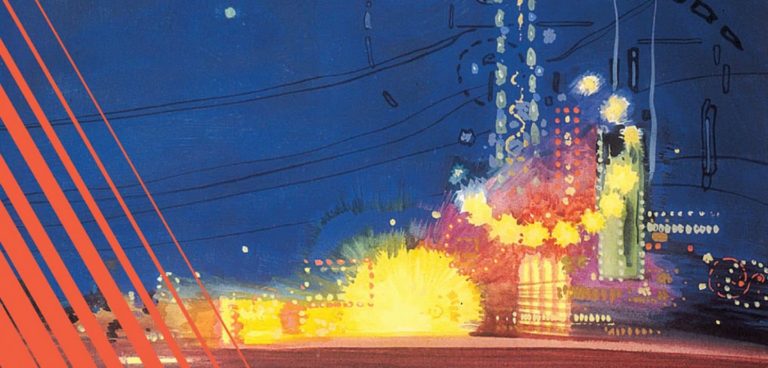A refracted vision of America
The Great Gatsby is like a mirror of the America of the 1920s. America in the Great Gatsby is a fundamental notion and the novel cannot be studied without the historical context of the time.
The novel reflects the Jazz Age or the Roaring Twenties and the opposition between East and West.
The Great Gatsby emphasizes the strange association between materialism and spiritualism, which is crucial to the Puritan ethic. Gatsby is seeking wealth because he is pursuing an idealistic vision.
A corrupted vision
The Crack-Up (1937) is a collection of short stories by F.S. Fitzgerald where he tried to catch the mood prevailing in the 1920s.
The mood was characterised by hedonism, the search for pleasure: “America was going on the greatest gaudiest spree in history”. Spending money to be part of the show means society is more based on appearance than substance.
The time of the action is the summer of 1922. America, after World War 1, has become the most prosperous and thriving nation in the world. It is the period of the Golden Boom (America has sold weapons and has become rich) and widespread corruption is at its apogee.
Bribery was a frequent practice. It has been shown by historians that after the Civil War, corruption was nothing compared to the Roaring Twenties. Even if the 1850s carpetbaggers took advantage of the situation of that time, it was far less important than in the 1920’s.
Corruption also marks the weakening of spiritual and moral values. After the butchery of World War I, disillusion had set in and therefore isolationism was striking rich.
In the 1920s, political circles were also corrupted. Warren Harding, president from 1921 to 1923, was marked by a series of scandals. In the summer of 1923, the president died in mysterious circumstances.
The 18th Amendment of the Constitution voted in January 1920, laid down that producing and selling alcohol would be forbidden. The Prohibition, also known as “the noble experiment”, triggered an increase in delinquency.
Al Capone belonged to that context. In people’s collective mind, the image of the bootlegger was worshipped and admired because the bootlegger was the man who dared to resist, to rise against the law.
The historical background
The Great Gatsby is based on a series of events published in the newspapers. F.S. Fitzgerald did not invent all the facts: he shaped and created a character who was emblematic of his time.
In The Great Gatsby, apart from Gatsby, we find characters based on real figures such as Meyer Wolfshiem, who is actually Arnold Rothstein, a master of the New York underworld.
In Chapter 4, at the metropole, the guy shot down was based on reality, it happened before the novel was written: he was gunned down because he had ratted on Becker, the corrupt NYPD chief.
The results of the 1919 baseball championships were fixed. In the text, Meyer Wolfshiem is responsible for tampering with the results while in reality, it is all Arnold Rothstein.
In Chapter 4, we learn that Wolfshiem lives above the laws: “They can’t get him old sport. He’s a smart man”. Arnold Rothstein was nicknamed “the brain”, “the bankroll”, and “the Morgan of the Underworld”. A Morgan is a magnate, a nabob, a tycoon in the capitalist 19th century.
Gatsby’s models in real life
One of Fitzgerald’s models for Gatsby came from a trial that took place in New York: the Fuller-McGee case. Edward M. Fuller, one of the two men, had been a neighbour of Fitzgerald’s in Long Island.
The Fuller-McGee case concerned illegal speculation. They both had been partners in a brokerage firm. Yet, it was soon discovered that they had cheated people. Later on, it was proved that Fuller and McGee were acting for Rothstein, the head of the New York underworld.
We can suspect Fitzgerald is to Fuller what Nick Carraway is to Gatsby.
Gatsby has earned a lot of money very quickly, more or less illicitly. He also polished his manners: “It took me three years”.
Gatsby is said to have had a hand in “the drug business” and in “the oil business”: there is no precision and his business remains quite vague.
The clue to the truth is that Gatsby must have earned a lot of money through shady dealings and illegal transactions. This is spelt out at the end of the book, after Gatsby’s death, when Nick answers the phone call: “Young… in trouble. They picked him up when he handed the bonds over the counter”.
We can therefore conclude that Gatsby has been involved in the trafficking of bonds.
Other historical hints
The Great Gatsby is a novel of the 1920s and alludes to eugenic theories: to get rid of mentally-retarded people by forbidding them to have children because of the belief in the possibility of improving the race.
Tom Buchanan defends Spengler’s thesis The Decline of the West – which claims that the degeneracy of America was caused by inferior races – in chapter 1: “Civilization is going to pieces”.
He mentions a book by Goddard, The Rise of the Coloured Empire, which does not exist but Stoddard had published articles pretending to demonstrate the intellectual superiority of Nordic groups over the Alpine, Mediterranean and negro groups. It is scientific racism.
The Fable of East and West
From West to East: the reversed American paradigm
A paradigm is a typical pattern or model. The Western displacement is turned back upon itself. It is superseded by the lure of the East.
The East appeals to the characters whereas the West is exemplified by Minnesota, where Gatsby comes from.
| West (Minnesota) | East (New York) |
| – dull rectitude (boring moral severity) | – sophisticated dissipation (luxury and easy life and pleasure) |
| – lacklustre (without any colours) | – hedonism and epicureanism (Gatsby’s parties) |
It is therefore understandable that characters are willing to escape towards the East. In the novel, the western frontier – which was a target for the previous generation – no longer exists. Gatsby reverts an American myth and Nick reminds the reader that the American dream is now dead and gone.
Gatsby is a descendant of a Dutch sailor but he is going to travel in the wrong direction (from West to East) at a time when the frontier has become anachronistic, a thing of the past since 1920. The frontier only exists on a spiritual level.
Gatsby’s mythic East
Gatsby’s dream is romantic, belonging to a vanished past. It is interesting to wonder what happened before he ended up in West Egg.
Gatsby’s social ascent has been possible through a series of encounters.
Dan Cody embodies the America of pioneers and adventurers. He became a multi-millionaire by extracting copper and Gatsby became his partner, a sort of surrogate son.
The meeting of Dan Cody is significant as he is a man of another age, a pioneer-debauchee convinced he could have everything with money. He is the mythical tough guy of the West, a sort of cowboy as we can see in chapter 6: ” the savage violence of the frontier…”.
In the second stage, Gatsby understands that the ruthlessness of the frontier man is a thing of the past. Success not only depends on money, it also depends on an image of respectability.
Meyer Wolfshiem is the post-war successor of Dan Cody. He is not involved physically but supervises the production of bootleg gin (an illegal and clandestine business during the Prohibition). He is the gang leader.
The word “gonnegtions” indicates that he is probably a Jew as it is the way Jews pronounce it. He must be a recent immigrant. His favourite activity is racketeering on a huge scale.
Ironically, Gastby’s dream of self-improvement should push him towards a world of law-breaking criminals, as if it had become impossible to achieve the early pioneers’ ambition. Accepting corruption is the price to pay. The dream that was idealised at first turns out to be corrupted. The dream is killed, once and for all.
Was the East and West polarity abolished?
Ironically, at the end of The Great Gatsby, the journey from West to East is followed by a trip back to West. Nick does not return to a pure and innocent West but to a place he hated at the beginning. There is a streak of melancholy at the novel’s closure.
The East failed to live up to the character’s expectations as the West proved to be as stultifying as ever.
The two places are equally disappointing and the only sentiment left to Nick is the lyrical evocation of this unique moment in time when sailors could find a continent as huge as their wonders.
Between power and dream: Gatsby’s America
Horatio Algier’s success literature
There is an attention between material values and spiritual aspirations. Fitzgerald was writing in the tradition of success stories. The materials used were rags-to-riches romances in the American Dream.
For Max Weber, the myth of success goes back to 17th-century bourgeois England, when they became powerful. It went to America with the Founding Fathers. The same story was popularised by Benjamin Franklin who spoke highly of hard-working, early-rising, self-disciplined, and ambitious adventurers. This model of self-imposed discipline influenced James Gatz.
Hopalong Cassidy was a book of far-west adventures. Gatsby used to read this series of books. This vision of the West was accompanied by notes from Benjamin Franklin and two images were combined: the cowboy riding West and notes taking up Franklin’s proverbs.
Horatio Algier always has a hero with a strong personality and with luck and pluck. The story of The Great Gatsby points to the limitation of Algier’s stories. It is through speculation that Gatsby will realise the dream which, in Algier’s stories, is achieved through hard work. It is a perversion of the model of the success story.
Materialism and Spiritualism: the American blend
The central paradox is that the main protagonist, Jay Gatsby, is an idealist who pursues a dream: to conquer Daisy. All his life is centred around the young woman but the only means to seduce her is to acquire money.
Spiritualism is closely bound up with materialism. Gatsby’s romantic ideal can only be achieved through speculating, bootlegging, and embezzling.
The Great Gatsby, through its sentimental and romantic plotline, highlights an ambiguity that is central to the American experience. On the one hand, the idealism is palpable with references to Keats. On the other hand, heavy materialism is present in gangs.
Gatsby is a passionate lover in search of transcendence but is also a speculator at the same time.

